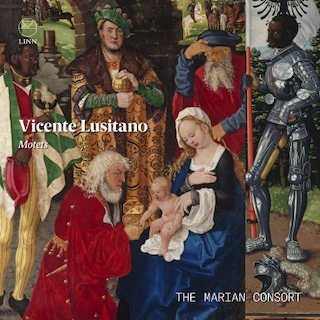
The Marian Consort, with Artistic Director Rory McLeery (far right)
By Robert Hugill
 Vicente Lusitano: Motets
Vicente Lusitano: Motets
The Marian Consort
LINN Records
“I, like most people, had never heard of Lusitano,” admits acclaimed opera singer and composer Roderick Williams. “The whole idea of The Marian Consort doing their research about him is that he has been forgotten by history–through malice, through ignorance. We are beginning to wake up, all of us, to the idea that there were mixed-race composers in the past.” (From “The great 16th-Century black composer erased from history” by Holly Williams, 16 June 2022 in BBC.com/Culture)
This disc from The Marian Consort presents a little more than a third of the total surviving output of a composer who virtually disappeared from the historical record. There are no known verified portraits of Vicente Lusitano, but his work remains, and herein the Marian Consort offers a glimpse into one of the composer-theorist’s richly imaginative work, performed with luminous clarity
Like many Renaissance composers, we know frustratingly little about the life of Portuguese composer Vicente Lusitano. Even his name isn’t a help; it simply means Portuguese. He appears in the historical record for around a decade, then disappears again. Later sources fill in some background, but a manuscript by João Franco Barreto written in the mid-seventeenth century, provides one important key. João Franco Barreto describes Lusitano as “pardo,” a Portuguese term used to denote a mixed-race person of European and African parentage. Thanks to the flourishing slave trade in 16th century Portugal, there was a significant population of people of African descent. Lusitano was a priest, and whilst mixed-race men did become priests the salaried posts were all reserved for white men.

Salve Regina, composed by Vincente Lusitano, performed by The Marian Consort on Vicente Lusitano: Motets
Thanks to the publication of his book of motets in Rome in 1551, Lusitano becomes the first published Black composer. During the 1550s, Lusitano was the music tutor to the son of the Portuguese ambassador to the Holy See, and the book of motets is dedicated to the ambassador, so it is presumably him that we can thank for the book’s production. Unlike some composers, Lusitano’s music does not seem to have been spread by word of mouth with manuscript copies circulating. His reputation during his lifetime was mainly as a theorist rather than as a composer, and some of his music was created to demonstrate these theories.
So, what do we have of Lusitano? Well, there is the published book from 1551, Liber primus epigramatum—“the first composition, that we know of, by a Black person,” writes Joseph McHardy in The Guardian of 16 June 2022–containing 23 motets, plus a published treatise and another manuscript treatise, both of which are concerned with improvised counterpoint. The manuscript treatise includes one of Lusitano’s motets as a demonstration. There is also one intriguing survival, one of Lusitano’s motets in a book from the ducal court in Stuttgart, dated 1562. The historical record for Lusitano stops at 1561 when he seems to have converted to Protestantism, married and was seeking a post in Germany. This disc of Vicente Lusitano’s motets from The Marian Consort, artistic director Rory McCleery, on Linn Records, provides us with something of an overview. The ensemble presents ten of Lusitano’s motets, performed by a vocal ensemble of 15 singers.

Sancta mater, istud agas, composed by Vicente Lusitano, performed by The Marian Consort on Vicente Lusitano: Motets
Some of the motets on the disc are deliberate homages to Josquin, setting the same text and including elements of parody. One of these is the eight-voice motet Preter rerum seriem with its slow-moving cantus in the soprano part and three alto parts creating a sense of stately seriousness. This is rich, sober, traditional music asking to be performed in a glorious acoustic. The five-voiced Regina Coeli is more mobile, more varied with a great deal of imitation to delightfully mobile effect.
Aspice Domine (five voices) returns us to the more sober style, slightly stately but full of lovely details and rich textures. As with several motets on the disc, Lusitano seems to have all the time in the world and uses this to create structures that are large-scale and wonderfully varied, and sometimes the harmonic shifts are intriguing, not quite what might be expected. Ave spes nostra (five voices) has a gloriously dark texture with the low voices predominating to striking effect, the imitations giving the music movement and a certain restlessness over the harmonic stability.

Ave spes nostra, Dei genitrix, composed by Vicente Lusitano, performed by The Marian Consort on Vicente Lusitano: Motets
Salve Regina (six voices) is another Josquin homage, adding an extra voice to Josquin’s original. The way the voices move in imitation round the cantus firmus gives a striking rocking motion to the music.
Heu Domine (four voices) comes from Lusitano’s treatise and features a strikingly chromatic main theme, which gives the music a harmonic instability that is striking and moves Lusitano much further towards Gesualdo and away from Josquin. If Lusitano’s earlier motets on this disc have tended towards static harmonies enlivened by mobile textures, this explores the harmonic possibilities implicit in the chromaticism.
With Emendemus in melius (five voices) we return to Lusitano’s more familiar style except with can sometimes detect hints of the other Lusitano, that from Heu Domine, in some of intriguing harmonic shifts. Sancta Maria (six voices) again give us Lusitano spinning engagingly mobile textures.

Regina caeli, composed by Vicente Lusitano, performed by The Marian Consort on Vicente Lusitano: Motets
Setting part of the Stabat Mater, the five-voiced Sancta mater, istud agas shows Lusitano’s delight at working on a large scale, the sober sound world enlivened by plenty of imitation and chant-like lines weaving in and out of each other. It is music for the moment, with all the time in the world, ending with a glorious Amen.
The longest work on the disc, Inviolata (eight voices) is another Josquin homage. Structurally imaginative including a deft canon, the work belies all this complex detail. Instead, we are taken by the gloriously rich, slow-moving texture. This certainly isn’t Josquin, Lusitano is glorying in the rich, imaginative textures.
The singing here always has a luminous clarity to it, so that Lusitano’s textures are presented with each line clear yet the whole drawing together with a richness and warmth that the music deserves. This is a lovely disc, one which makes Lusitano’s music stand out, making us want to explore his sound world further. I do hope that it compels other groups to explore this neglected repertoire.
Reviews published here by permission of Robert Hugill at Planet Hugill, a singer, composer, journalist, lover of opera and all things Handel. To receive Robert’s lively “This month on Planet Hugill” e-newsletter, sign up on his Mailing List. (Robert Hugill photo by Robert Piwko. This review was published at Planet Hugill on 6 June 2022.
***

From Lusitano’s composition manual Introduttione Facilissima (Credit: IMSLP/Public Domain)
Who Was Vicente Lusitano?
More on Lusitano: excerpts from “Vicente Lusitano: Why was the first Black published composer just a footnote in histories?” by Joseph McHardy in The Guardian, 16 June 2022
Vicente Lusitano was born in Olivença, then a Portuguese city, around 1520. He was ordained a priest, was in Rome by 1551, and travelled to Germany 10 years later. Crucially, he was described as “pardo” by his first biographer. The term signified a mixed-race person of white European and African parentage. Lusitano was Black.

Sancta Maria, composed by Vicente Lusitano, performed by The Marian Consort on Vicente Lusitano: Motets
There is no known record of Lusitano’s background but, given the level of education generally required of composers of the time, and the common usage of “pardo” to suggest Black mixed-race, it is easy to speculate that he was born to a white father and a Black mother.
There is also no record of Lusitano ever holding a church post, the usual job for male European composers in that era. Portugal reserved salaried roles in the church for white clergy; regardless of ability, Black clerics were excluded. Citing the dedication in Lusitano’s first publication, music historian Robert Stevenson supposed that he worked as a tutor to the aristocratic Lencastre family. We have a record of Lusitano in Rome in 1551. That same year, the Lencastres moved to Rome as ambassadors at the papal court. Lusitano even wrote a piece about it–Quid montes, Musae. Perhaps Lusitano travelled to Rome with the Lencastres in the hope of persuading the pope to allow him to secure a church post, but it never happened. By 1561 he had converted to Protestantism, married, and was on his way to Germany, probably in the hope of securing a position there.

Aspice Domine, composed by Vicente Lusitano, performed by The Marian Consort on Vicente Lusitano: Motets
Yet he managed to become one of the most prolific Black artists of early modern Europe. 1551 saw the printing of Liber primus epigramatum – 23 motets, the first published composition, that we know of, by a Black person. Written for choir, to be performed in church services, it would take an ensemble several hours to perform the whole book in one sitting. Given the exclusion he probably faced, that Lusitano published at all is a massive achievement. A work of music theory followed in 1553, running to three editions, and Lusitano also completed a lengthy manuscript treatise on the art of singing. A further motet, Beati omnes qui timent Dominum, exists in a book copied at the ducal court in Stuttgart, dated 1562–perhaps the only example of a 16th-century Catholic-born Iberian writing specifically for Protestant liturgy.
Lusitano’s compositions are sonorous and intricate. Like his contemporaries, he writes in a style where single ideas generate lines for multiple voices which weave around each other: counterpoint. And counterpoint matters to classical music. Bach, Mozart and Beethoven all studied the counterpoint perfected by Renaissance composers. It is at the root of classical music. For composition students, it’s their times tables. Counterpoint became one of the things that marked classical music as European.

Emendemus in melius, composed by Vicente Lusitano, performed by The Marian Consort on Vicente Lusitano: Motets
What happened to Lusitano’s memory has happened to countless other Black people in Europe’s history. The discrimination they faced didn’t end at their deaths. Nineteenth-century Europe’s music histories had no room for Black people. Even today, uncovering classical music’s Black history can lead to hostile reactions.
After 1561, Lusitano disappears from the historical record. The hoped-for job in Germany didn’t materialize and he became a footnote in histories of the period.



